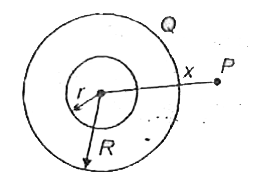Assertion : A and B are two conducting spheres of same radius. A being solid and B hollow. Both are charged to the same potential. Then, charge on A= charge on B.
Reason : Potentials on both are same.
If both Assertion and Reason are true and Reason is the correct explanation of Assertion.
If both Assertion and Reason are true but Reason is not correct explanation of Assertion.
If Assertion is true but Reason is false.
If Assertion is false but Reason is true.
The correct Answer is:A
To solve the question, we need to analyze the assertion and reason provided.
Assertion: A and B are two conducting spheres of the same radius. A is solid and B is hollow. Both are charged to the same potential. Then, charge on A = charge on B.
Reason: Potentials on both are the same.
1. Understanding the Given Information:
- We have two conducting spheres, A (solid) and B (hollow), both with the same radius.
- Both spheres are charged to the same potential.
2. Formula for Electric Potential:
- The electric potential V at the surface of a conducting sphere is given by the formula:
V=kQR
where k is Coulomb's constant, Q is the charge, and R is the radius of the sphere.
3. Applying the Formula:
- For sphere A (solid):
VA=kQAR
- For sphere B (hollow):
VB=kQBR
4. Setting the Potentials Equal:
- Since both spheres are charged to the same potential, we can equate the potentials:
VA=VB
This gives us:
kQAR=kQBR
5. Simplifying the Equation:
- The k and R terms cancel out (since they are the same for both spheres):
QA=QB
6. Conclusion:
- Therefore, the charge on sphere A is equal to the charge on sphere B, confirming the assertion.
Evaluation of the Reason:
- The reason states that the potentials on both are the same. While this is true, it does not explain why the charges must be equal. The equality of charges arises from the relationship between charge and potential, but the reason does not directly address this relationship. Thus, while both the assertion and reason are true, the reason is not a correct explanation for the assertion.
Final Answer:
- The assertion is true, but the reason is not a correct explanation for the assertion. Therefore, the correct option is B.
---
- We have two conducting spheres, A (solid) and B (hollow), both with the same radius.
- Both spheres are charged to the same potential.
- The electric potential V at the surface of a conducting sphere is given by the formula:
V=kQR
where k is Coulomb's constant, Q is the charge, and R is the radius of the sphere.
- For sphere A (solid):
VA=kQAR
- For sphere B (hollow):
VB=kQBR
- Since both spheres are charged to the same potential, we can equate the potentials:
VA=VB
This gives us:
kQAR=kQBR
- The k and R terms cancel out (since they are the same for both spheres):
QA=QB
- Therefore, the charge on sphere A is equal to the charge on sphere B, confirming the assertion.
- The reason states that the potentials on both are the same. While this is true, it does not explain why the charges must be equal. The equality of charges arises from the relationship between charge and potential, but the reason does not directly address this relationship. Thus, while both the assertion and reason are true, the reason is not a correct explanation for the assertion.
- The assertion is true, but the reason is not a correct explanation for the assertion. Therefore, the correct option is B.
Topper's Solved these Questions
- ELECTROSTATIC POTENTIAL AND CAPACITORSBOOK - DC PANDEY ENGLISHCHAPTER - ELECTROSTATIC POTENTIAL AND CAPACITORSEXERCISE - (C) Chapter exercises
50 Videos
- ELECTROSTATIC POTENTIAL AND CAPACITORSBOOK - DC PANDEY ENGLISHCHAPTER - ELECTROSTATIC POTENTIAL AND CAPACITORSEXERCISE - (A) Chapter exercises
227 Videos
- ELECTROMAGNETIC WAVESBOOK - DC PANDEY ENGLISHCHAPTER - ELECTROMAGNETIC WAVESEXERCISE - Sec C
22 Videos
- ELECTROSTATICSBOOK - DC PANDEY ENGLISHCHAPTER - ELECTROSTATICSEXERCISE - Medical entrances gallery
37 Videos
Similar Questions
Knowledge Check
Metallic sphere of radius R is charged to potential V. Then charge q is proportional to
AVBRCboth V and RDnone of these
Two metallic spheres have same radii One of them is solid and the other is hollow. They are charged to the same potential. The charge on the former is q1 and that of the latter is q2. We have
View SolutionIf a solid and a hollow conducting sphere have same radius then
View SolutionA conducting sphere of radius R is given a charge Q. The electric potential and the electric field at the centre of the sphere respectively are
View SolutionA conducting sphere of radius R is given a charge Q. The electric potential and the electric field at the centre of the sphere respectively are
View SolutionTwo concentric hollow conducting spheres of radius r and R are shown. The charge on outer shell is Q. what charge should be given to inner sphere so that the potential at any point P outside the outer sphere is zero ?

View SolutionThere are two conducting spheres of radius a and b (b>a) carrying equal and opposite charges. They are placed at a separation d (>>> a and b). The capacitance of system is

View SolutionA number of spherical conductors of different radii are charged to same potential. The surface charge density of each conductor is related with its radius as
View Solution
